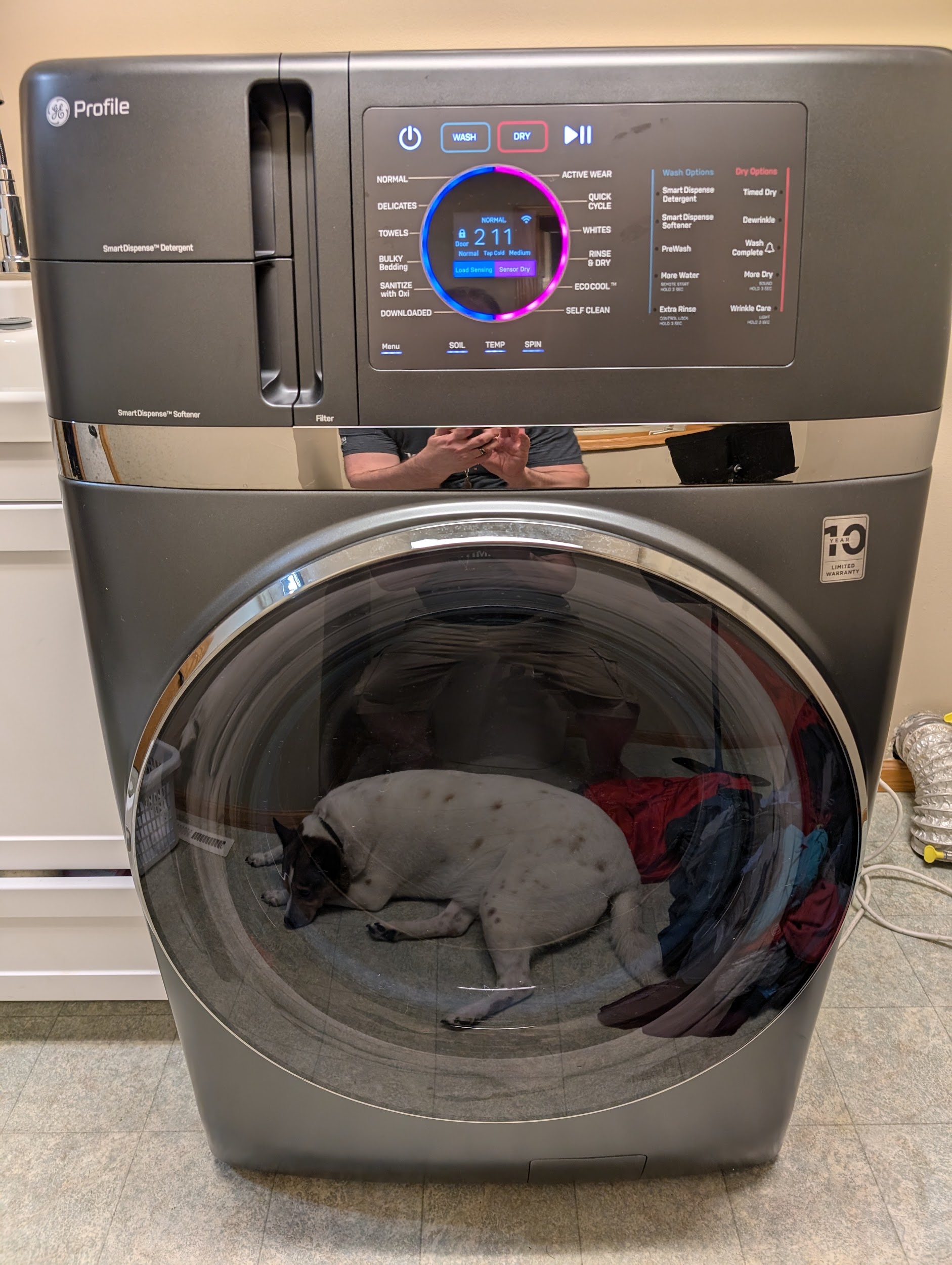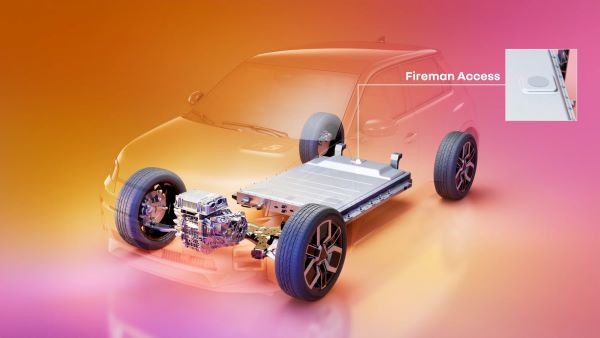Sign up for daily news updates from CleanTechnica on email. Or follow us on Google News!
The efficiency of heat pumps for tackling carbon emissions has often been covered here on CleanTechnica thanks to Joe Wachunas, who has quite often shared his expertise in this area. With heat pumps, you typically get a 3-to-1 bonus in the heat produced vs. the energy expended in the electricity! The benefit achieved depends on the coefficient of performance, which itself depends on the temperature of the lower and upper reservoirs, speaking in an ideal theoretical sense that is covered in a college thermodynamics course.
My family recently purchased a GE Profile all-in-one washer/dryer that not only saves space in your laundry room (with other benefits as well, and we’ll get to that), but also uses a heat pump for the drying cycle to save energy. The price of this washer/dryer is not cheap, at $2300 at Best Buy and other retailers on sale.
That said, it is meant to replace both a washer and dryer, so you have to add up those separate costs. In our case, we had a washer that needed a $1000 repair as quoted by Excelsior Appliance, and so repair wasn’t worthwhile. The dryer, on the other hand, was probably a 30-year-old Kenmore by the looks of it, which we inherited when we bought our house. The dryer was still working fine, if very inefficiently, running on 240 V and maybe drawing 20 amps or so.
All in, the GE Profile cost us $2800, including the sale price, sales tax, installation, hauling off the old appliances, and springing for the Best Buy protection plan. We sprung for the protection plan due to the GE Profile being rather new with a not-so-great warranty included. That is not so cheap, and considering only a stand-alone heat pump dryer makes sense if you don’t need a washer replacement and if you aren’t space-constrained.
Using The GE Profile Washer / Dryer
Using the GE Profile is very straightforward. It comes with a manual that I admittedly haven’t read, as well as a get-started card. In this review, I’ve run a mix of clothes through a “normal” cycle, which I only had to adjust to using cold water via a simple press of the “temperature” button, which cycles through available temperatures. When adding clothes, I was cognizant of not overfilling it beyond ⅔ full, as overfilling would likely just extend the drying cycle.
That said, I have run several loads, one less than half full, a couple about half full, and a couple ⅔ full. All of these loads ended with good results regarding obtaining a dry load at the end of the cycle. The GE Profile will vary its drying time based on the load size via its ability to sense how dry the load currently is.
As an added bonus, the GE Profile comes with “dog grooming mode!” No, that is just my dog’s reflection, wanting to be close at hand :-).
The time on the display shows 2 hours, 11 minutes, which is the time you should expect for a load that is a little more than half full. This is a downside to an all-in-one, as with two separate appliances you can wash and dry in parallel. That said, you also don’t have to spend transfer time, nor worry about letting a washer load sit, and if you just chill and do other things waiting for the appliance to finish, you are all good!

Energy Usage
I plugged the unit into a Kill-A-Watt in order to track its energy usage. I was a bit worried here as I had to use an extension cord in order to actually be able to see the readings on the Kill-A-Watt. I checked, by feel, quite regularly to make sure the cord wasn’t getting hot! I don’t recommend using an extension cord long term without monitoring.
During the dry cycle, I took a picture of this power draw. The maximum power draw I noted was 1160 Watts, which at 120 Volts amounts to 9.7 Amps (P = IV).

At the end of the wash/dry cycle (washing and drying is the default), I just hit the “KWH” button on the Kill-A-Watt, which then displayed the total energy used in kWh. Drumroll please … this amounted to just 1.25 kWh! Here in Minneapolis that is about US 20 cents worth of electricity for a combined wash/dry cycle. I think that is excellent, given that an electric dryer might draw 20 Amps at 240 Volts for an hour, which would amount to 20*240 / 1000 = 4.8 kWh just for drying! My numbers for a typical dryer amperage draw and drying time are probably off, so let me know in the comments if that is the case.
How Well Does It Dry?
After the end of the default drying cycle, which I recommend so as not to over-cook your clothes, the claim by GE is that the environment that your clothes are sitting in is hot and humid, and that each item of clothing deserves a few shakes before folding. I can confirm this, and since you likely want to give your clothes a few shakes to get the wrinkles out, no worries!
Also, as I was washing clothes in a clean-out-the-closet-get-rid-of-pet-hair exercise so that said clothes were suitable for donation maybe, one load sat overnight. I found that the next day the clothes were ever so slightly damp, but only minimally so. So no worries if that is the case, just leave them in the laundry basket for a few hours before putting them away in a drawer. Or if hanging up, proceed.
The GE Profile also has settings for drying more thoroughly, but I haven’t explored that feature as that is likely unnecessary and will just use more energy and maybe shrink your cotton clothes.
Additional Benefits
The GE Profile has a couple of additional benefits, one obvious, and the other perhaps unexpected! First, it frees up space as you can repurpose the space that the dryer formerly occupied. But the second benefit is a much bigger deal. If you have a 240 Volt circuit running to the laundry room, now that circuit will no longer be dedicated for your dryer.
Hmm… what else could that 240 Volt circuit be repurposed for? Perhaps charging an EV! And without having to come up with a solution that switches between the two applications.
International Cooperation
GE appliances are manufactured in the US. However, the company was sold to Haier a few years back. If the GE Profile washer/dryer proves to be reliable, perhaps this is a model for cooperation between China and the US going forward. You own some of ours, we own some of yours, and we commit to local production!
There is also a new similar model from Samsung if you want to support South Korean ownership.
Two Recommendations
I recommend leaving the door open after a load to properly dry out, although the time for that is minimal due to the heating cycle. Also, clean out the lint filter after every load and leave it open to properly dry out. This will prevent mildew, etc.
Summary
All in one washer/dryers are a new thing here in the United States. Given that they have a heat pump for the drying cycle, they only need to operate on 120 Volts. My experience is that the GE Profile washer/dryer works very well and is energy efficient by perhaps a factor of 3 or 4 to boot! It saves labor and also energy. What is not to love?
By Matt Fulkerson
Have a tip for CleanTechnica? Want to advertise? Want to suggest a guest for our CleanTech Talk podcast? Contact us here.
Latest CleanTechnica.TV Videos
CleanTechnica uses affiliate links. See our policy here.





